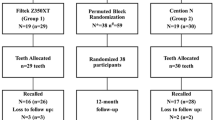Abstract
Objectives
The objective of the study is to evaluate the success rate of amalgam restorations in manually prepared cavities under field conditions within a comprehensive school-based oral health-care program in high caries-risk children.
Materials and methods
A total of 1322 restorations were placed in the permanent teeth of 619 high caries risk Filipino children by two dentists and two trained health-care workers. Only hand instruments and an encapsulated amalgam, mixed with a manually powered amalgamator, were used. The restorations were evaluated after a service time of 1 to 5 years using modified atraumatic restorative treatment (ART) criteria.
Results
The overall success rate of the amalgam restorations was 95.3 % (n = 1260) after a mean service time of 2.7 years (SD = 1.4). Multiple-surface restorations showed significantly higher failure rates (11.4 %) than single-surface occlusal (4.7 %) and single-surface non-occlusal (2.1 %) restorations; 93.6 % of large restorations was performed successfully, but had a risk of failure twice to that of small restorations (odds ratio (OR) = 2.141). The score of the decayed, missing, and filled teeth (DMFT) index had significant influence on the success rate. The risk of restoration failure increased by 11.5 % for each unit increase in DMFT (OR = 1.148). Neither the operator nor age nor gender of the patient had a significant effect on the success rate of the restorations.
Conclusion
Amalgam was performed satisfactorily as a filling material when placed under field conditions in manually prepared cavities in the permanent dentition of high caries-risk children. Success of the restorations was influenced by the patient’s caries experience (DMFT), restoration size, and service time.
Clinical relevance
Manual restorative treatment (MRT) amalgam restorations were performed satisfactorily, but higher dental caries experience and large cavities contribute to lower success rates.
Similar content being viewed by others
References
van Palenstein Heldermann W, Benzian H (2006) Implementation of a basic package of oral care: towards a reorientation of dental NGOs and their volunteers. Int Dent J 56:44–48
Department of Education, Philippines (2008) National oral health survey among the public school population in the Philippines 2006, Manila
Smales RJ, Yip HK (2002) The atraumatic restorative treatment (ART) approach for the management of dental caries. Quintessence Int 33:427–432
Frencken JE, Holmgren C (1999) Atraumatic restorative treatment for dental caries. STI Book, Nijmegen
Frencken JE, Pilot T, Songpaisan Y, Phantumvanit P (1996) Atraumatic restorative treatment (ART). Rationale, technique, and development. J Public Health Dent 56:135–140
Frencken JE, Holmgren C (1999) How effective is ART in the management of dental caries? Community Dent Oral Epidemiol 27:423–430
Frencken JE, Leal SC, Navarro MF (2012) Twenty-five-year atraumatic restorative treatment (ART) approach: a comprehensive overview. Clin Oral Investig 16:1337–1346
de Amorim RG, Leal SC, Frencken JE (2012) Survival of atraumatic restorative treatment (ART) sealants and restorations: a meta-analysis. Clin Oral Investig 16:429–441
Zanata RL, Fagundes TC, Freitas MCCA, Lauris JRP, Navarro MFL (2011) Ten-year survival of ART restorations in permanent posterior teeth. Clin Oral Investig 15:265–271
Yip HK, Smales RJ, Ngo HC, Tay FR, Chu FCS (2001) Selection of restorative materials for the atraumatic restorative treatment (ART) approach: a review. Spec Care Dentist 21:216–221
Mickenautsch S, Yengopal V, Banerjee A (2010) Atraumatic restorative treatment versus amalgam restoration longevity: a systematic review. Clin Oral Investig 14:233–240
Qvist J, Qvist V, Mjör IA (1990) Placement and longevity of amalgam restorations in Denmark. Acta Odontol Scand 48:297–303
Bernardo M, Luis H, Martin MD, Leroux BG, Rue T, Leitao J, DeRouen TA (2007) Survival and reasons for failure of amalgam versus composite posterior restorations placed in a randomized clinical trial. JADA 138:775–783
Sjögren P, Halling A (2002) Long-term cost of direct class II molar restorations. Swed Dent J 26:107–114
Fathi M, Mortazavi V (2004) A review on dental amalgam corrosion and its consequences. J Res Med Sci 1:42–51
Monse-Schneider B, Heinrich-Weltzien R, Schug D, Sheiham A, Borutta A (2003) Assessment of manual restorative treatment (MRT) with amalgam in high-caries Filipino children: results after 2 years. Community Dent Oral Epidemiol 31:129–135
Frencken JE, Leal SC (2010) The correct use of the ART approach. J Appl Oral Sci 18:1–4
Mandari GJ, Frencken JE, van’t Hof MA (2003) Six-year success-rates of occlusal amalgam and glass-ionomer restorations placed using three minimal intervention approaches. Caries Res 37:246–253
Mandari GJ, Truin GJ, van’t Hof MA, Frencken JE (2001) Effectiveness of three minimal intervention approaches for managing dental caries: survival of restorations after 2 years. Caries Res 35:90–94
Oral Health Surveys. Basic methods, 4th Ed. (1997) World Health Organisation, Geneva
Frencken JE, Makoni F, Sithole WD (1998) ART restorations and glass ionomer sealants in Zimbabwe: survival after 3 years. Community Dent Oral Epidemiol 26:372–381
Phantumvanit P, Songpaisan Y, Pilot T, Frencken JE (1996) Atraumatic restorative treatment (ART): a three year community field trial in Thailand—survival of one-surface restorations in the permanent dentition. J Public Health Dent 56:141–145
Holmgren CJ, Lo ECM, Hu D, Wan H (2000) ART restorations and sealants placed in Chinese school children—results after three years. Community Dent Oral Epidemiol 28:314–320
Taifour D, Frencken JE, Beiruti N, van’t Hof MA, Truin GJ, Van Palenstein-Heldermann W (2003) Comparison between restorations in the permanent dentition produced by hand and rotary instrumentation—survival after 3 years. Community Dent Oral Epidemiol 31:122–128
Burton P, Gurrin L, Sly P (1998) Extending the simple linear regression model to account for correlated responses: an introduction to generalized estimating equations and multi-level mixed modelling. Stat Med 17:1261–1291
Rasines Alcaraz MG, Veitz-Keenan A, Sahrmann P, Schmidlin PR, Davis D, Iheozor-Ejiofor Z (2014) Direct composite resin fillings versus amalgam fillings for permanent or adult posterior teeth (Review) Cochrane Library 2014, Issue 3
Rasines Alcaraz MG, Veitz-Keenan A, Sahrmann P, Schmidlin PR, Davis D, Iheozor-Ejiofor Z (2014) Amalgam or composite fillings—which material lasts longer? Evid Based Dent 15:50–51
Manhart J, Chen H, Hamm G, Hickel R (2004) Buonocore Memorial Lecture. Review of the clinical survival of direct and indirect restorations in posterior teeth of the permanent dentition. Oper Dent 29:481–508
Hickel R, Manhart J (2001) Longevity of restorations in posterior teeth and reasons for failure. J Adhes Dent 3:45–64
Lo ECM, Holmgren CJ, Hu D, van Palenstein HW (2007) Six-year follow up of atraumatic restorative treatment restorations placed in Chinese schoolchildren. Community Dent Oral Epidemiol 35:387–392
Farag A, van der Sanden WJM, Abdelwahab H, Frencken JE (2011) Survival of ART restorations assessed using selected FDI and modified ART restoration criteria. Clin Oral Investig 15:409–415
Mijan M, de Amorim RG, Leal SC, Mulder J, Oliveira L, Creugers NHJ, Frencken JE (2013) The 3.5-year survival rates of primary molars treated according to three treatment protocols: a controlled clinical trial. Clin Oral Investig. doi:10.1007/s00784-013-1077-1
Trachtenberg F, Maserejian NN, Tavares M, Soncini JA, Hayes C (2008) Extent of tooth decay in the mouth and increased need for replacement of dental restorations: the New England Children’s Amalgam Trail. Pediatr Dent 30:388–392
Soncini JA, Maserejian NN, Trachtenberg F, Tavares M, Hayes C (2007) The longevity of amalgam versus compomer/composite restorations in posterior primary and permanent teeth. JADA 138:763–772
Correa MB, Peres MA, Peres KG, Horta BL, Barros AJ, Demarco FF (2013) Do socioeconomic determinants affect the quality of posterior dental restorations? A multilevel approach. J Dent 41:960–967
Opdam NJM, Bronkhorst EM, Loomans BAC, Huysmans CDNJM (2010) 12-year survival of composite vs. amalgam restorations. J Dent Res 89:1063–1067
Wang L, Lopes LG, Bresciani E, Lauris JRP, Mondelli RFL, Navarro MFL (2004) Evaluation of class I ART restorations in Brazilian schoolchildren: three-year results. Spec Care Dent 24:28–33
van Gemert-Schriks MCM, van Amerongen WE, ten Cate JM, Aartman IHA (2009) Three-year survival of single- and two-surface ART restorations in high-caries child population. Clin Oral Investig 11:337–343
Goldstein GR (2010) The longevity of direct and indirect posterior restorations is uncertain and may be affected by a number of dentist, patient-, and material-related factors. J Evid Base Dent Pract 10:30–31
Frencken JE, Taifour D, van’t Hof MA (2006) Survival of ART and amalgam restorations in permanent teeth of children after 6.3 years. J Dent Res 85:622–626
Frencken JE, van’t Hof MA, Taifour D, Al-Zaher I (2007) Effectiveness of ART and traditional amalgam approach restoring single-surface cavities in posterior teeth of permanent dentition in school children after 6.3 years. Community Dent Oral Epidemiol 35:207–214
WHO Consensus statement on dental amalgam (1997) FDI World 6:9
Council of European Dentists (2010) CED-resolution on dental amalgam; CED-DOC-2010-085-E-FIN
International Organization for Standardization (1995) Standard 1559 dental materials – alloys for dental amalgam, Geneva
Benzian H, Monse B, Belizario V Jr, Schratz A, Sahin M, van Palenstein Heldermann W (2012) Public health in action: effective school health needs renewed international attention. Glob Health Action. doi:10.3402/gha.v5i0.14870
Conflict of interest
The authors declare that they have no conflict of interest.
Author information
Authors and Affiliations
Corresponding author
Rights and permissions
About this article
Cite this article
Schüler, I.M., Monse, B., Holmgren, C.J. et al. Success rates of manual restorative treatment (MRT) with amalgam in permanent teeth in high caries-risk Filipino children. Clin Oral Invest 19, 1493–1500 (2015). https://doi.org/10.1007/s00784-014-1374-3
Received:
Accepted:
Published:
Issue Date:
DOI: https://doi.org/10.1007/s00784-014-1374-3




